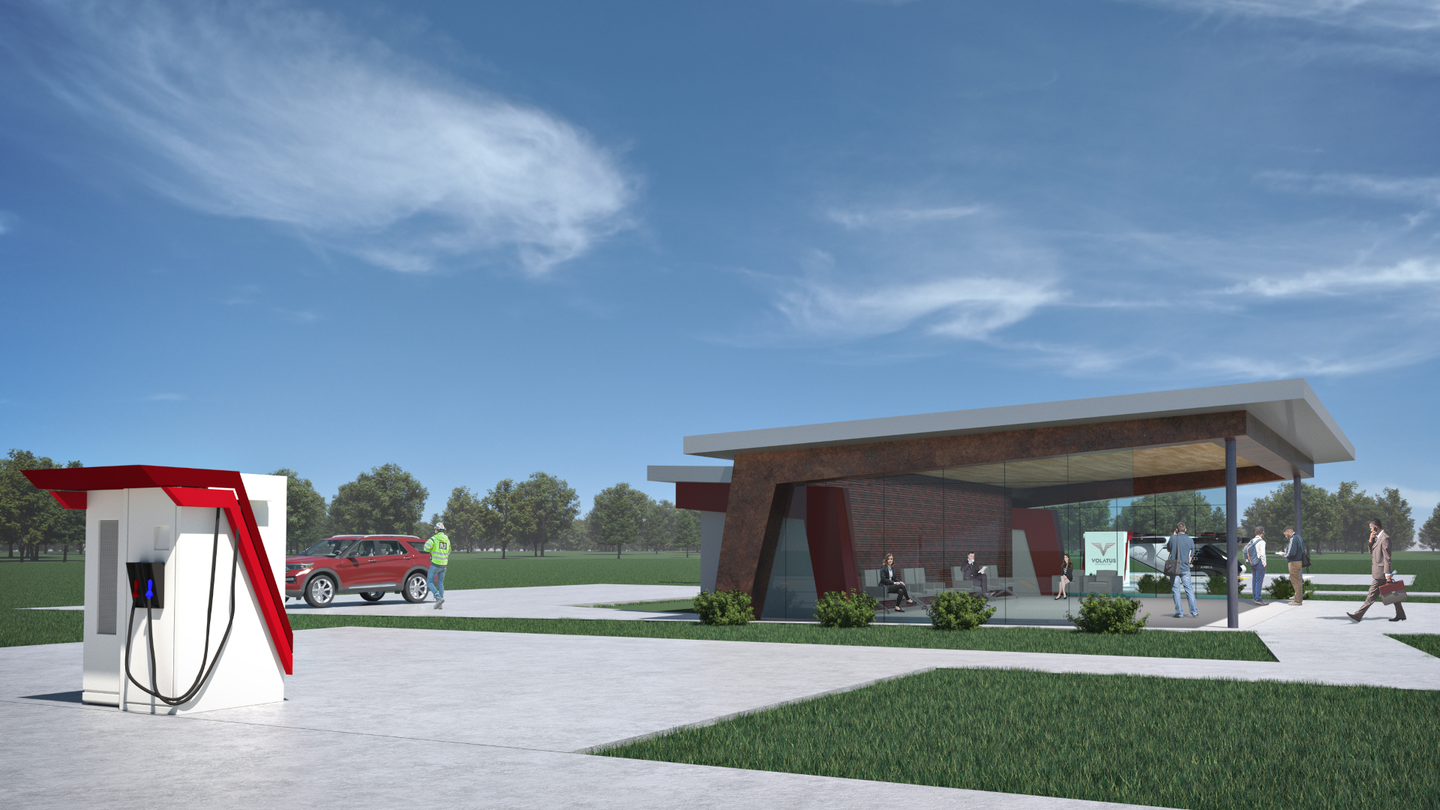Volatus to Add Vertiport to Texas ‘Green Airport’ Project
The company’s third proposed vertiport is planned for Greenport International Airport, a sustainable airport under construction near Austin, Texas.

A digital rendering of a Volatus vertiport, which also includes an eVTOL charging station. [Courtesy: Volatus Infrastructure]
For advanced air mobility (AAM) to reach the level of service envisioned by the FAA and other stakeholders, electric vertical takeoff and landing (eVTOL) aircraft will need more locations to take off and land.
While heliports figure to do some of the legwork, the U.S. will require more vertiports designed specifically for eVTOL aircraft. Volatus Infrastructure, one of the firms building those airfields, on Tuesday announced its third planned vertiport at Greenport International Airport (GIA), a sustainable airport project currently under construction near Austin, Texas.
Volatus’ letter of intent with Greenport builds on the firm’s commitments to construct vertiports at Wittman Regional Airport (KOSH) in Oshkosh, Wisconsin and Bellefonte Airport (KN96) in Pennsylvania. The company also has strategic agreements with eVTOL manufacturers such as SkyDrive, Air, and Plana to allow them to use its facilities and will be the exclusive vertiport provider for eVTOL fleet management company EVFly.
Each Volatus vertiport will receive eVTOL traffic management services from Embraer’s Eve Air Mobility and will be outfitted for drone delivery services through a partnership with Valqari. Agreements with real estate companies such as JLL, meanwhile, will support the company’s efforts to open more locations across the U.S.
Volatus’ Greenport vertiport is expected to open in early 2024.
“This partnership is revolutionary for the AAM industry,” said Grant Fisk, co-founder of Volatus and a member of the National Air Transportation Association’s AAM Committee. “Greenport is going to set the tone and create standards for the U.S. vertiport market by being one of the first FAA-compliant, fully operational eVTOL vertiports open.”
Greenport International Airport—a 2,600-acre project under construction in Bastrop County, Texas, 17 miles outside Austin—is expected to be “fully sustainable off-grid” and privately owned and operated. It will feature a 10,000-foot runway, 2.9 million square feet of hangar space, and now a vertiport, primarily serving large business jets and AAM aircraft.
The airport will be surrounded by the 2,800-acre Greenport International Technology Center, a corporate campus with 9 million square feet of data center space and research and development facilities. Both projects are supported by real estate developer CBRE Group and Carpenter and Associates, a local corporation that first unveiled the concept in 2010.
Greenport also has its share of detractors, who claim the development would pose a danger or nuisance to local residents. They add that the decision to undertake the project was made without public input. And interestingly, opponents say the airport may actually harm the environment.
CBRE and Carpenter and Associates did not immediately respond to FLYING’s request for comment.
Greenport is billed as “the world’s first green airport,” but others claim they have already achieved net-zero operations.
Swedavia, a Swedish airport group, eliminated Scope 1 and 2 emissions at 10 facilities in 2020, reaching net-zero airport operations. The group does not address Scope 3 emissions, which come from aircraft themselves. But Airports Council International (ACI) Europe lists Swedavia as the only operator to achieve the organization’s net-zero goals.
Vertiports, like the ones Volatus plans to build, could speed international aviation sustainability goals by promoting the use of electric aircraft.
In June 2021, ACI World, its five member regions, and its 1,950 member airports committed to reaching net-zero carbon emissions from airport operations by 2050. Industry leaders at the National Business Aviation Association Business Aviation Convention and Exhibition would announce the same target a few months later.
This spurred the U.S. to roll out its own “net-zero by 2050” goal in November 2021. The following April, the FAA got involved, partnering with U.S. airports to eliminate carbon emissions from airport operations. The U.K., too, is targeting zero-emissions airport operations by 2040.
In fact, 235 airports across 29 European countries pledged to do away with carbon emissions in 2021, a number that expanded to over 300 airports last month. Of those, 132 are set to fully decarbonize by 2030.
ACI World publicly promoted the International Air Transport Association’s Net-Zero Roadmaps, released in June, as a model for airports making the switch. It also teamed with the World Economic Forum to launch the Airports of Tomorrow initiative, which aims to bring together public and private stakeholders committed to reducing airport emissions.
Volatus and Greenport, though, may offer a complementary solution: constructing a net-zero airfield from the ground up. So far, no airport operator has launched carbon-free operations from the jump. But, if construction stays on schedule for early 2024, that could soon change.

Sign-up for newsletters & special offers!
Get the latest FLYING stories & special offers delivered directly to your inbox






